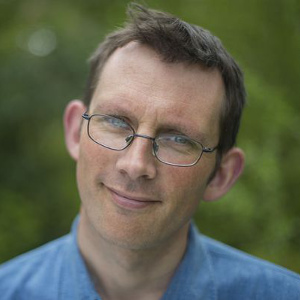What would it sound like to live in a future in which beavers were now considered an essential part of our now rapidly-rewilding landscapes? If flooding in towns and cities across the UK was now hugely reduced thanks to the remarkable hydrological reengineering of the landscape done by these hard-working mammals higher up in the catchments for those watersheds? If their reintroduction had led to an explosion of biodiversity? Curious as always, last summer I once again hopped into my Time Machine and set off to find out.

Having set the dials and put the date into my very stylish new touch sensitive decade togglers (available from timemachineparts.com), I arrived in 2030 by the side of a lake near Laddock in Cornwall. It was early evening, and the first impression, in the stillness, was how incredibly alive the place was. Every few seconds a fish leaped from the water attempting to catch one of the many insects flying low over the water. Birds sang, bats swooped, the initial sense of calm and quiet gave way to a sense of incredibly vibrant life in a wide diversity of forms. Here’s a taste of what that 2030 sounded like:

What do beavers eat? C.S.Lewis might have convinced you that they eat fish, but in fact they eat trees and plants.
While sitting there, I meet Chris Jones, whose farm it is, out for his evening walk by the ponds. He tells me that it was back in 2017 that the beavers were reintroduced, and their effect on the land around them has been profound. I asked him what impact he had seen the beavers have on the biodiversity that was already there. As we sat looking out over the ponds with the dusk deepening, he told me “if you have a stream or river without beavers, it’s like a little garden bonfire of biodiversity. If you put beavers in it’s like throwing petrol onto the bonfire. There’s nothing else like it in the temperate world for bringing life”. As another fish leaped from the water, the average size of which has increased eightfold since the beavers arrived, it wasn’t hard to see what he meant.
“We’ve had them in Cornwall”, he went on, “since 2017, so we’re 13 years into the process, and from a number of enclosures we’ve now got beavers out into quite a number of the rivers and streams in Cornwall. Partly as a factor of our landscape, they’re not really causing much conflict with farming, but they are bringing back an awful lot of water into our headwaters, and keeping it there in times of flood and drought, they’re entertaining visitors to our county, they are hosting a huge amount of wildlife, and in quite a few places they are now starting to provide some serious natural flood management”.

My terrible photo of a swimming beaver… (it was dusk and it was keeping its distance)…
He pointed to the series of ponds created by the beavers that now mean that huge amounts of water are stored in the landscape, and over 16 tons of silt that would otherwise have been washed out into the sea has been trapped in the ponds. “One pair of beavers on 200 metres have done that”, he told me. “What if we had 10 pairs of beavers across the whole catchment? I don’t think it (Laddock, the nearby town that has experienced serious flooding in the past) would ever flood. It would be very hard to see how it could flood”.
The moment the he first saw an actual beaver moving through the water was just magical, a reenchantment of the landscape. Thrilling in such an unexpected way. “The best thing is the look on people’s faces when they first see on. Just a gift..”

I asked him how it felt now, in 2030, to be able to not only see the impacts of what he had initiated when we introduced the beavers back in 2017, but also to be able to see that the idea has now transformed his own catchment also inspired the same in many others across the country. He told me “to be able to see this explosion of nature going on in our valleys and our streams has been phenomenal. There’s nothing like it that we could have done ourselves that would have been approaching this in terms of effect. The years are getting hotter and drier, but look here, we’re just surrounded by water, and greenness, and life. It’s that abundance that we need to be fostering. Things have really moved on”.
Indeed they have.
You don’t need to wait until 2030 to visit the beavers at Chris’s farm near Laddock in Cornwall. Find out about upcoming tours here. Time Machine optional.






